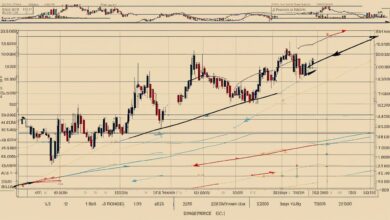Summer Stock Market Survival Kit for Investors

Key Highlights
- The stock market rally in 2024 has slowed down due to concerns about inflation and interest rates.
- Investors are uncertain the Federal Reserve’s stance on rate cuts and how it will impact the stock market.
- Higher inflation and volatility have made investors cautious about their summer trading strategies.
- Wall Street’s hopes a smooth summer have been dampened by the possibility of a more challenging economic environment.
- Investors need to be more discerning in their stock picks and consider risk management techniques to safeguard their portfolios.
- The performance of different sectors in the stock market may vary during the summer months, requiring investors to focus on sector-specific strategies.
Introduction
The summer months can be a challenging time for investors as the stock market often experiences increased volatility and uncertainty. Factors such as seasonal trends, historical data, and sector performance can all influence the stock market during this period. To navigate these challenges and make the most of the summer trading season, it is essential for investors to have a summer stock market survival kit. This survival kit should include essential elements such as understanding seasonal trends, analyzing historical data, implementing sector-specific strategies, and managing risk effectively. By having these tools at their disposal, investors can increase their chances of success in the stock market during the summer months.
Essential Elements of Your Summer Stock Market Survival Kit
To survive and thrive in the summer stock market, investors need to have a well-prepared survival kit. This kit should include essential elements that will help them navigate the challenges and make informed investment decisions. Understanding seasonal trends in the stock market is crucial as it can provide valuable insights into market behavior during the summer months. Analyzing historical data can help investors identify patterns and trends that can inform their trading strategies. Sector-specific strategies are also essential as different sectors may perform differently during the summer. Finally, effective risk management techniques are crucial for safeguarding portfolios in the face of increased volatility.
1. Understanding Seasonal Trends in the Stock Market
Seasonal trends play a significant role in the stock market, and understanding these trends can help investors make more informed decisions. During the summer months, the stock market often experiences increased volatility, lower trading volumes, and a shift in investor sentiment. This can be attributed to factors such as vacations, market participants taking time off, and a generally slower pace of economic activity. By recognizing these seasonal trends, investors can adjust their trading strategies accordingly. They can be more cautious during periods of high volatility, focus on sectors that tend to outperform during the summer, and be prepared for potential market fluctuations. Overall, understanding seasonal trends in the stock market is an essential element of a summer stock market survival kit.
2. Historical Data Analysis: Summer Months Performance
Analyzing historical data is an essential element of a summer stock market survival kit. By studying past performance during the summer months, investors can gain valuable insights into how the stock market has behaved in similar conditions. This analysis can help them identify patterns and trends that can inform their trading decisions. For example, historical data may reveal that certain sectors tend to outperform during the summer, while others may lag behind. It may also indicate periods of increased volatility or periods of relative stability. By having this information, investors can adjust their investment strategies accordingly and increase their chances of success in the stock market.
| Outperforming Sectors | Technology, Consumer |
| Lagging Sectors | Utilities, Energy |
| Periods of Increased Volatility | Beginning and End of Summer |
| Periods of Relative Stability | Mid-Summer |
3. Sector-Specific Strategies for Summer Trading
Implementing sector-specific strategies is an important element of a summer stock market survival kit. Different sectors tend to perform differently during the summer months, and investors can take advantage of these trends by focusing on specific sectors. For example, technology and consumer discretionary sectors have historically performed well during the summer, driven by innovations and increased consumer spending. On the other hand, sectors such as utilities and energy may face challenges due to market turbulence and changing dynamics. By identifying sector-specific opportunities and tailoring their trading strategies accordingly, investors can improve their chances of success in the stock market during the summer.
4. Risk Management Techniques for Volatile Summer Months
Managing risk effectively is a crucial element of a summer stock market survival kit, especially during periods of increased volatility. Volatile summer months can pose challenges for investors, as market fluctuations can lead to significant gains or losses. To mitigate risk, investors should consider implementing risk management techniques such as setting stop-loss orders to minimize losses and diversifying their portfolios to reduce exposure to individual stocks or sectors. Additionally, monitoring market indicators for timely decision-making can help investors navigate the ups and downs of the stock market. By implementing these risk management techniques, investors can safeguard their portfolios and minimize the impact of market volatility during the summer months.
5. Effective Trading Strategies for the Summer
Having effective trading strategies is a crucial element of a summer stock market survival kit. By employing the right strategies, investors can maximize their chances of success in the stock market during the summer months. Here are some effective trading strategies to consider:
- Focus on sectors that historically perform well during the summer, such as technology and consumer discretionary.
- Utilize technical analysis to identify trends and patterns in stock prices.
- Diversify your portfolio to reduce risk and exposure to individual stocks or sectors.
- Stay informed about market news and events that may impact stock prices.
- Be prepared for increased volatility and adjust your trading strategy accordingly.
By incorporating these trading strategies into your summer stock market survival kit, you can navigate the challenges and opportunities of the market with confidence.
Diving Deeper into Summer Trading Strategies
While the essential elements of a summer stock market survival kit provide a solid foundation, diving deeper into specific trading strategies can help investors further refine their approach. By exploring topics such as navigating low volume trading days, identifying opportunities in sector rotation, utilizing technical analysis for summer trends, and leveraging ETFs for diversification, investors can gain a deeper understanding of the intricacies of summer trading. These strategies can enhance their decision-making process and potentially lead to more successful outcomes in the stock market.
1. Navigating Low Volume Trading Days
Low volume trading days are common during the summer months when many market participants are on vacation or taking time off. These days can present unique challenges and opportunities for investors. On one hand, lower trading volumes can result in increased volatility and sharper price movements. On the other hand, they can also create opportunities for astute investors to identify mispriced assets and make profitable trades. Navigating low volume trading days requires careful analysis and risk management. Investors should be mindful of liquidity constraints and adjust their trading strategies accordingly. They should also be prepared to act swiftly and take advantage of any favorable market conditions that may arise.
2. Identifying Opportunities in Sector Rotation
Sector rotation refers to the shifting performance of different sectors in the stock market over time. Identifying opportunities in sector rotation is a crucial aspect of summer trading. By closely monitoring sector performance and identifying sectors that are likely to outperform or underperform, investors can adjust their portfolios accordingly. This involves recognizing trends and patterns in sector rotation and making informed investment decisions based on these observations. For example, if a particular sector is expected to outperform during the summer, investors may consider increasing their exposure to stocks within that sector. Conversely, if a sector is expected to underperform, they may reduce their exposure or seek opportunities in other sectors.
3. Utilizing Technical Analysis for Summer Trends
Technical analysis is a valuable tool for investors looking to identify trends and patterns in stock prices. By utilizing technical analysis, investors can analyze historical price data, identify support and resistance levels, and make informed trading decisions based on these insights. During the summer months, when market conditions can be more volatile, technical analysis can help investors navigate market fluctuations and identify potential entry and exit points. This involves using indicators such as moving averages, trend lines, and chart patterns to assess market sentiment and make predictions about future price movements. By incorporating technical analysis into their trading strategies, investors can gain a deeper understanding of summer trends and potentially improve their trading outcomes.
4. The Role of ETFs in Diversification During Summer
Exchange-traded funds (ETFs) play a crucial role in diversifying portfolios and reducing risk, especially during the summer months when market conditions can be more unpredictable. ETFs offer investors exposure to a basket of securities, allowing them to gain diversification benefits without having to individually select and manage multiple stocks. By investing in ETFs that track different sectors or asset classes, investors can spread their risk and potentially mitigate the impact of market volatility. Additionally, ETFs provide liquidity, which can be particularly beneficial during low volume trading days. By incorporating ETFs into their summer trading strategies, investors can enhance their portfolio diversification and potentially achieve more stable investment returns.
Sector Focus: Winning and Losing Sectors of the Summer
Understanding the performance of different sectors during the summer months is essential for investors looking to make informed investment decisions. Certain sectors tend to outperform, while others may lag behind during this period. By focusing on winning sectors such as technology and consumer discretionary, investors can take advantage of growth opportunities. Conversely, sectors such as utilities and energy may face challenges during the summer months. By analyzing sector-specific trends and dynamics, investors can align their investment strategies with the performance of different sectors and potentially enhance their trading outcomes.
1. Technology: Innovations Driving Growth
The technology sector has been a consistent performer during the summer months, driven by ongoing innovations and advancements. Companies in this sector often introduce new products and services during the summer, attracting investors’ attention and driving growth. Technologies such as artificial intelligence, cloud computing, and e-commerce continue to transform industries and create new opportunities for investors. By focusing on technology stocks that are at the forefront of these innovations, investors can potentially benefit from the sector’s growth potential during the summer.
2. Consumer Discretionary: Summer Spending Habits
The consumer discretionary sector is another winning sector during the summer months, largely due to increased consumer spending habits. During the summer, consumers tend to spend more on travel, leisure activities, and other discretionary goods and services. Companies in the consumer discretionary sector, such as hotels, restaurants, and retail brands, often see a boost in sales during this period. By investing in consumer discretionary stocks that cater to summer spending habits, investors can potentially capitalize on the sector’s growth opportunities.
3. Utilities: A Safe Haven During Market Turbulence?
Utilities are often considered a safe haven during market turbulence, including the summer months. These companies provide essential services such as electricity, water, and natural gas, which are in demand regardless of market conditions. During periods of increased volatility, investors may flock to utility stocks for their relative stability and income-generating potential. While utilities may not offer the same growth opportunities as other sectors, they can provide a defensive position in a portfolio and potentially withstand market fluctuations. By including utility stocks in their summer trading strategies, investors can diversify their holdings and potentially reduce risk during turbulent market periods.
4. Energy: Summer Dynamics and Its Impact
The energy sector experiences unique dynamics during the summer months, which can impact its performance. Factors such as increased demand for air conditioning, summer travel, and changes in oil prices can influence the energy sector’s profitability. For example, higher oil prices can benefit energy companies involved in exploration, production, and transportation. Conversely, lower oil prices may impact profitability and stock performance. By understanding these summer dynamics and their impact on the energy sector, investors can make informed investment decisions and potentially capitalize on opportunities in this sector.
Risk Management: Safeguarding Your Portfolio in the Heat
Managing risk effectively is critical for investors looking to safeguard their portfolios during the summer months. Increased volatility and unpredictable market conditions can pose challenges, but implementing risk management techniques can help investors mitigate potential losses. Setting stop-loss orders to minimize losses, diversifying portfolios to reduce exposure to individual stocks or sectors, and monitoring market indicators for timely decision-making are all important aspects of risk management. By incorporating these techniques into their summer trading strategies, investors can protect their portfolios and manage risk effectively.
1. Setting Stop Loss Orders to Minimize Losses
Setting stop-loss orders is an effective risk management technique that can help investors minimize losses during periods of increased volatility. A stop-loss order is an instruction to sell a security when it reaches a predetermined price level. By setting stop-loss orders, investors can limit potential losses and protect their portfolios from significant declines. This technique allows investors to establish an exit strategy in advance and avoid emotional decision-making during market downturns. By incorporating stop-loss orders into their summer trading strategies, investors can safeguard their portfolios and minimize the impact of market volatility.
2. The Importance of Portfolio Diversification
Portfolio diversification is a crucial risk management technique that can help investors safeguard their portfolios during the summer months. Diversification involves spreading investments across different asset classes, sectors, and geographic regions to reduce the impact of any single investment. By diversifying their portfolios, investors can potentially minimize the impact of market fluctuations and reduce risk. For example, if one sector or asset class underperforms during the summer, the investor’s portfolio may be buffered by the performance of other investments. In addition, diversification can provide opportunities for potential growth by including a mix of assets with different risk and return profiles. By emphasizing portfolio diversification in their summer trading strategies, investors can protect their portfolios and potentially achieve more stable investment returns.
3. Monitoring Market Indicators for Timely Decisions
Monitoring market indicators is an essential aspect of risk management and timely decision-making in the stock market. Market indicators provide valuable insights into market sentiment, trends, and potential opportunities or risks. By closely monitoring indicators such as the S&P 500 index, the volatility index (VIX), and economic reports, investors can stay informed about market conditions and make timely investment decisions. For example, a rising VIX may indicate increased market volatility, prompting investors to reassess their risk exposure or adjust their trading strategies. By incorporating market indicators into their summer trading strategies, investors can make more informed decisions and potentially navigate market fluctuations more effectively.
Conclusion
Navigating the summer stock market requires a strategic survival kit. By understanding seasonal trends, historical data analysis, and sector-specific strategies, investors can stay ahead. Risk management techniques and effective trading strategies are vital during volatile months. Diversification with ETFs and focusing on winning sectors like technology and consumer discretionary can lead to success. Remember, safeguarding your portfolio with stop loss orders, diversification, and monitoring market indicators is key. Stay informed and prepared to make timely decisions in the ever-changing market landscape. Summer trading demands a proactive approach to maximize opportunities and mitigate risks effectively.
Frequently Asked Questions
What Makes the Stock Market Behave Differently in Summer?
The stock market can behave differently during the summer months due to various factors. Seasonal trends, such as lower trading volumes and increased volatility, can influence market behavior. Additionally, market indicators and economic reports can impact investor sentiment and drive market fluctuations during the summer.







